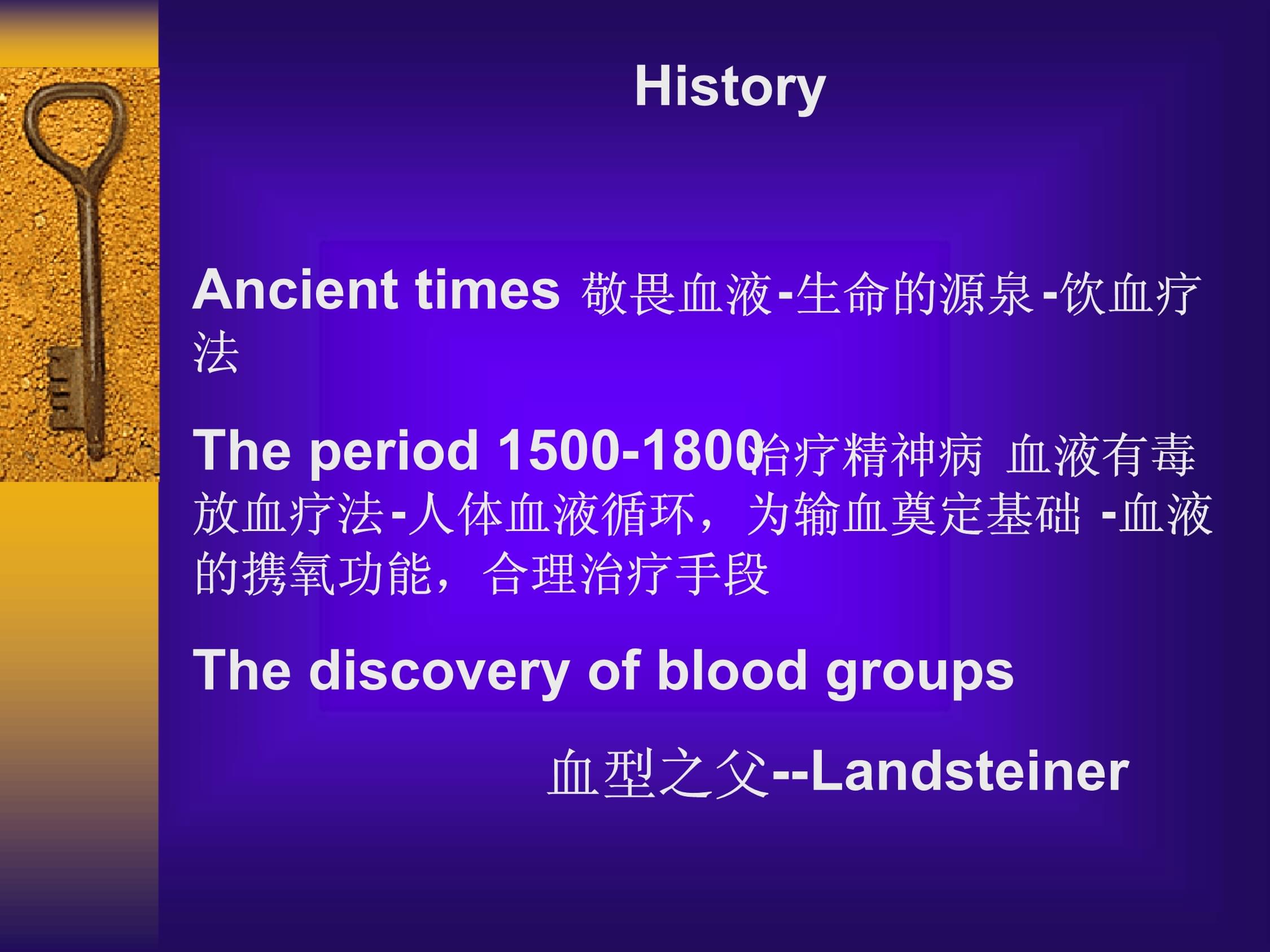




版权说明:本文档由用户提供并上传,收益归属内容提供方,若内容存在侵权,请进行举报或认领
文档简介
1、Testing Specimen Requirement2ml EDTA whole blood Fill in the tube label(s) with name临床输血学实验Transfusion Medicine(blood transfusion laboratories)上海市第六人民医院Shanghai Sixth People Hospital输血科Transfusion DepartmentHistoryAncient times 敬畏血液-生命的源泉-饮血疗法The period 1500-1800 治疗精神病血液有毒放血疗法-人体血液循环,为输血奠定基础-血液的携氧功能
2、,合理治疗手段The discovery of blood groups 血型之父-Landsteiner人类血型的发现,为安全输血提供重要保证。而且,在遗传学、人类学、法医学、免疫学、部分疾病的发病机制探讨上也具有重要意义。While blood cell antigens:?Red cell antigens?HLA antigens?Granulocytes-specific antigensPlatelets(22)Part oneRed blood cell group目的要求:掌握ABO血型的鉴定熟悉Rh血型的鉴定ABO SYSTEMPrinciple of procedure?红
3、细胞上具有A抗原者为A型-RedbloodcellspossessAbloodgroupantigens?有B抗原者为B型-RedbloodcellspossessBbloodgroupantigens?A和B抗原都没有者为O型-RedbloodcellslackAandBbloodgroupantigens?A和B抗原都有者为AB型-RedbloodcellspossessAandBbloodgroupantigensRh SYSTEM?The most complex in the red cells antigen?Individuals who possess the D antige
4、n are Rh positive, who lack it are Rh negative.?The D antigen is capable of stimulating production of Anti-D in persons lacking the D antigen. ?Anti-D is a clinically significant antibody capable of causing RBC destruction and may result in hemolytic disease of the newborn and transfusion reaction.
5、已发现的抗原40多个。涉及临床主要是5个抗原:C、c、D、E、e及其相应的特异性抗体。Four other antigens(C、c、E、e) account for almost all of the Rh-related transfusion problems. They are less antigenic than D, and/or the antibodies are less clinically dangerous.But they can cause the transfusion reaction.Materials Required?Centrifuge?0.9% sa
6、line?pipetter?reagents:The monoclonal antibody(IgM) include Anti-A 、Anti-B 、Anti-D 5% Standard RBC-AffirmagenMethods?Solid phase adherence test?Tube test?Gel test?Manual?Semi-automated system?Automated systemPROCEDURESpecimen collection and preparationRed blood cell suspensions(4%RBC) can be prepare
7、d using the following combinations of saline and packed red blood cells:Saline Volume-2mlPacked RBC Volume-100ul被检者RBC用生理盐水配成2-5%悬液待用(2ml 0.9% NS +100ul 压积红细胞)TEST PROCEDURE-tube test正定型:取小试管三只,分别用记号笔标记后加抗A、抗B、抗D血清各一滴,然后加受检者RBC悬液一滴。blood grouping ?Add one drop of Anti-A、Anti-B、Anti-D to three tubes
8、separately?Add one drop of a 2-5% RBC suspension to three tubes separatelyTEST PROCEDURE反定型:取小试管三只,分别用记号笔标记后加受检者血清一滴,然后加标准A、B及O型RBC各一滴。reverse grouping?Add one drop of serum/plasma to three tubes separately?Add one drop of 5% standard RBC to three tubes separately将上述混匀后静置数分钟或3000r/m离心15s肉眼判断凝集度。?Sha
9、ke gently to mix contents of reaction tubes.?Centrifuge six tubes with 3000r/s,15m.?Shake gently with 45-60 angles.?Evaluate six tubes for agglutination and/or hemolysis upon test completion.?Record the reaction strength on the paper.Evaluate the agglutination strength4+3+2+1+或W+一个结实的大凝块,背景清楚。数个结实的凝
10、块,背景清楚。中等大小的凝块加小凝块,背景清楚。小凝块,背景较浑浊。细胞有微小凝块,背景红色浑浊,通常用显微镜观察。混合外观凝集,少数红细胞形成较大的凝集块,而周围是游离的红细胞。阴性,红细胞呈游离状态,无凝集象溶血,有游离血红蛋白。MF0(negative)H(hemolysis)Interpretation of results Anti-AAnti-BAnti-DAcBcOcgrouping+A RhD positiveB RhD positiveO RhD positiveAB RhD positiveGrouping anomalies?Cold auto-antibodies?Ac
11、quired B?Unexpected mixed field reactions?Partial or weak D?D negative?Intrauterine transfusionsRhD negative verificationReagents: three different Anti-D human (IgG) monoclonal antibodyMethod?Indirect antiglobulin test (IAT)?Gene testIndirect antiglobulin test?Incubating the donors red cells with th
12、e Rh typing sera?Washing the cells three times?Adding AHG?Centrifuging the mixture?Observing it for agglutinationThe relationship between ABO group and personality O有一种表现自己的性格,行动受感情左右,喜欢政治,好胜心强,对立斗争有戒心与喜欢交友并存,能看清形势,很注意别人对自己的好恶.有信念和理想.率直,具有现时与罗曼蒂克双重性.言行带有夸张性,讲话带有教育人和教训人的语气A内心想法不愿为人所知.对别人情绪及环境变化有敏锐反应,
13、但对别人的想法缺乏客观理解.思想行动慎重而有规律,个性内向,没个性谨小慎微固步自封,遵从常理,重视家庭,富于计划性.擅长以说服和说明的调子讲话开放型对人缺乏戒心,情绪善变,活动力强,不原受约束,行动奔放光明正大反复无常,富于灵活性,欢热闹场合.固执己见,善于批评,先下结论后作说明BAB善于待人接物,很注意合情合理,期望在社会上施展能力,注意别人对自己的感情,厌恶表里不一.个性中庸,富有实践精神计划性强不喜欢指手划脚容易疲劳.表情不丰富,正式场合讲话呆板,回避感情激烈的讲话或事件ABO group and amativenessfemaleOBAABmalePart twoRed cell co
14、mpatibility testing-Crossmatch目的要求:掌握交叉配血试验的原理熟悉交叉配血试验的操作CROSSMATCHINGThe crossmatch is defined as a procedure to exclude incompatibility between donor and recipient. Crossmatching will pick up incompatibilities between the donor and recipient that will not be evident on blood typing (as blood typin
15、g is not available against every blood group, just the major ones). In addition, the crossmatch procedure will not pick up low titer antibodies and thus will not prevent delayed-type hemolytic transfusion reactions Immediate spin crossmatch?主侧配血-Majorcrossmatch(mostimportant)-comparingdonoreryghrocy
16、testorecipientserumantibodiesinrecipientserumagainstdonorerythrocytes.?次侧配血-MinorcrossmatchThiscomparesdonorserumtorecipienterythrocytesandchecksforpreformedantibodiesindonorserumthatcouldhemolyserecipientredcellsChoice of techniques?盐水介质-saline?酶介质-enzyme+liss?抗球蛋白介质-IATCrossmatch procedureMajorcro
17、ssmatch:Add1dof5%suspensionofdonorRBCsand1drecipientplasma/serumintothetube取受血者血清1-2滴+献血员2-5%红细胞盐水悬液1滴MinorcrossmatchAdd1dof5%suspensionofrecipientRBCsand1ddonorplasma/serumintothetube,取受血者2-5%红细胞盐水悬液1滴+献血员血清1-2滴将上述混匀后静置数分钟或3000r/m离心15s肉眼判断凝集度。Centrifuge six tubes with 3000r/s,15m.Shake softly with
18、45-60 angles.Evaluate two tubes foragglutination under the microscope.Result?When there is an incompatiblereaction on the major crossmatch, the donor blood should not be transfusion under any circumstances. ?When there is an incompatible reaction on the minor crossmatch, the transfusion can go ahead
19、. However, if the donated serum is likely to contribute substantially to the plasma volume of the recipient, the serum should be removed from the donor whole blood.Selection of blood?Red cell components-the same ABO and RhD group as the patient ?If ABO identical blood is not available-group O RBC +
20、group AB plasma?If RhD-negative blood are limited-RhD positive blood may be selected ?Patient with clinically significant red cell antibody?Patient with autoimmune haemolytic anaemia?Massive blood transfusionPart threeCoombstest目的要求:?掌握直接、间接抗人球蛋白试验的原理?熟悉直接、间接抗人球蛋白试验的操?了解直接、间接抗人球蛋白试验的临床应用一、抗人球蛋白试验的原理倘若用提纯的或在人的全血清内的人的球蛋白给动物(如兔和山羊)注射,动物对外来的蛋白质将会产生抗体,即抗人球蛋白。抗人球蛋白血清,在适当处理之后将会与人球蛋白发生特异性反应。如果球蛋白分子,或者抗体或补体附着于红细胞膜上,抗球蛋白血清将会与球蛋白结合。因为球蛋白附着于红细胞上,抗球蛋白血清与球蛋白分子的结合就引起红细胞凝集反之,将不会被凝集。直接抗球蛋白试验证实体内被致敏的红细胞。洗涤后的患者红细胞可直接进行
温馨提示
- 1. 本站所有资源如无特殊说明,都需要本地电脑安装OFFICE2007和PDF阅读器。图纸软件为CAD,CAXA,PROE,UG,SolidWorks等.压缩文件请下载最新的WinRAR软件解压。
- 2. 本站的文档不包含任何第三方提供的附件图纸等,如果需要附件,请联系上传者。文件的所有权益归上传用户所有。
- 3. 本站RAR压缩包中若带图纸,网页内容里面会有图纸预览,若没有图纸预览就没有图纸。
- 4. 未经权益所有人同意不得将文件中的内容挪作商业或盈利用途。
- 5. 人人文库网仅提供信息存储空间,仅对用户上传内容的表现方式做保护处理,对用户上传分享的文档内容本身不做任何修改或编辑,并不能对任何下载内容负责。
- 6. 下载文件中如有侵权或不适当内容,请与我们联系,我们立即纠正。
- 7. 本站不保证下载资源的准确性、安全性和完整性, 同时也不承担用户因使用这些下载资源对自己和他人造成任何形式的伤害或损失。
最新文档
- 人工智能与环境保护的科技创新
- 企业内部信息保护措施探讨
- 中华文化的国际传播策略与效果
- 中国传统节庆活动策划与执行
- 企业人力资源管理的信息安全管理
- 企业决策能力提升与领导力培养
- 人工智能与未来工作模式的变革
- 从理论到实践探讨智能机器人的应用
- 企业培训的多元化策略与方法
- 产品发布会的策划与执行流程分享
- 消防安全隐患排查试题及答案
- 2024年食品安全法管理知识试题库(含答案)
- 2025广西文化产业集团招聘174人易考易错模拟试题(共500题)试卷后附参考答案
- 宿舍管理考试试题及答案
- 2025福建德化闽投抽水蓄能有限公司招聘15人笔试参考题库附带答案详解
- 智能财税综合实训 上篇 课件 社会共享初级代理实务
- 2025年长春医学高等专科学校单招职业适应性考试题库参考答案
- 2024-2030全球细胞治疗制造平台行业调研及趋势分析报告
- 湖南省长沙市雨花区长沙市华益中学2024-2025学年九年级下学期开学考试英语试题(含答案无听力原文及音频)
- 术后谵妄的预防与护理
- 【参考】2016扣字排行榜

评论
0/150
提交评论